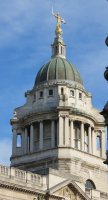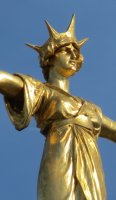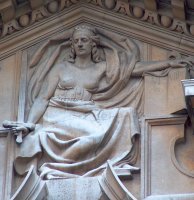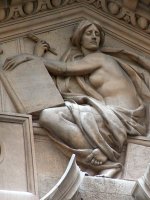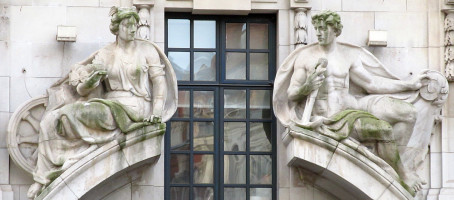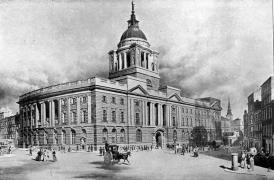Justice Statue, Old Bailey, by F.W. Pomeroy
The Statue of Justice on the Old Bailey in London is situated close to St Paul s Cathedral, on the street of Old Bailey running north from Ludgate Hill to Holborn.
The Justice Statue is one of the great iconic sculptures of London, and features in countless TV news reports as the ultimate representation of Justice when a grand trial commences or ends.
The figure of Justice is conventional in being a powerfully built woman, almost an Amazon, fully draped, and carrying her symbols of Sword and Scales. She stands tall and symmetrically, her arms stretched out to the sides, and the lines of her drapery a single garment wrapped round her slim body, sleeved at the top and falling to form a long skirt down to cover the feet below having some asymmetry but being close-wrapped enough to emphasise the balance of the figure from left to right. The scales in Justice's left hand, which are the usual pan balance, are without chains, and of a light construction so that they do not visually overpower the slim sword on the other side. The sword has to be less than massive, or it would not look right being held up in one hand; even so, only mighty Justice could stand thus for long - and she is standing motionless, with no sense that she is in arrested motion, for Justice is Eternal. She stands upon a globe, for Justice straddles the world.
Looking closely at the figure of Justice, we see that her features are Classical, Roman rather than Greek, bar the columnar neck, and her expression is fierce, with grim mouth and frowning brows, for Justice is stern. Her hair is not so long, and seems to be drawn or pinned in a bun at the back of her head, above her crown. This crown, spiky and sun-like, makes for an excellent silhouette against the sky.
Side and rear views of Justice.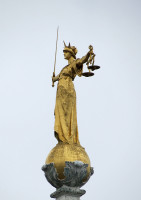
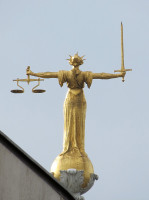
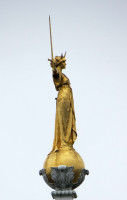
The sculptor was F. W. Pomeroy, one of the most important of the New Sculptors, and he also made most of the other sculpture on the exterior of the building, on which more in a moment. The Justice figure is extremely high up, around 200 ft above the road, and is therefore of some considerable size, being double height or 12 ft tall. The building, originally styled the New Sessions House, was put up between 1902 and 1907 to replace a previous Old Bailey, or Central Criminal Court, and the architect was E. W. Mountford.
Interior of the Old Bailey, sculpture by Pomeroy, and lunette by Gerald Moira.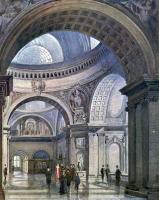
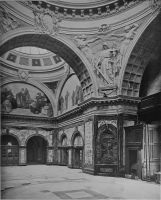
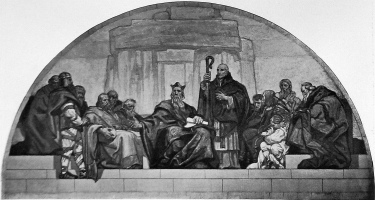
The building is a good example of an Edwardian Baroque edifice in the grand manner, large, confident and rich in decoration. Inside, the main feature is a grand hall with a dome, which alas I have not had opportunity to visit, and contains paintings by Gerald Moira and W. B. Richmond, along with further sculpture by Pomeroy depicting Justice, Mercy, Temperance and Charity. Other interior carving and is by Gilbert Seale, and William Aumonier, and Seale was also responsible for the ornamental plasterwork. The tiles are mostly by Doulton of Lambeth, and the leadwork is by the famous Birmingham company of Henry Hope and Sons.
Pomeroy's figure sculpture over the Old Bailey portico.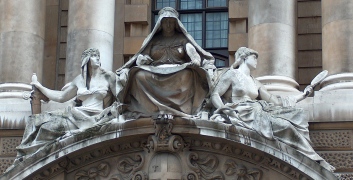
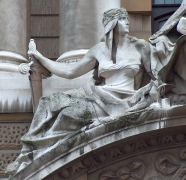
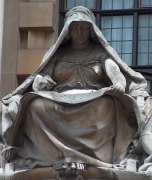
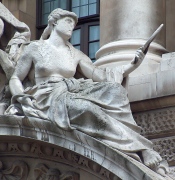
Back to the exterior. Above the main entrance are three female allegorical figures: the Recording Angel, with Fortitude and Truth. The Recording Angel - what a superb title - is a cowled figure, symmetrically disposed, writing on a long scroll; her hood has protected the relatively soft stonework within, so we can appreciate the youthful face much as it must have looked when first carved. The other figures have fared less well. Fortitude is worn and stained, but still an arresting figure, with great solid arms and shoulders, an athlete s neck, and heroic visage. If you like this sort of figure, see the page on Warrior Women. Truth is greatly worn, and has lost her nose, parts of her hands, and the surface of the statue is pitted. She reclines easily, gazing at her image in a round mirror, her other hand and lower arm with a snake entwined around it, which is a symbol of knowledge (see the Snakes page). She wears a thick drapery skirt, knotted at the waist or lap, and is bare-breasted, symbolical of unvarnished and uncovered Truth. The group as a whole, seated on the curved (segmental), open pediment of the portico, is elegantly composed, in a broad balanced triangle rising to the apex of the Recording Angel's head.
Higher up are pillars in front of a recessed area, with projecting bays on each side, and in the pediments of these are two further figures, in relief. To the left is a figure of Truth, a rather careworn figure, again semi-draped, revealing large biceps, with a wide belt under her breasts from which a long skirt depends; a further swirl of drapes in behind and above the figure. She carries a sword in her right hand, and the other rests upon a book of Law. The figure on the other side shows Pomeroy at his best, and in my view is one of the most beautiful semidraped figures in relief in Edwardian architectural sculpture. The profile of her torso, with her muscular arm and side contrasted with the soft form of her breast, and below, the line of the leg and the delicate underside of her foot, are a tour de force of sculpture. Again, she is of serious expression, definitely a more Edwardian than Classical face, and she rests one arm on her journal, the other holding a quill pen. A splendid creature.
Alfred Turner's Old Bailey panels.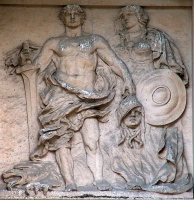
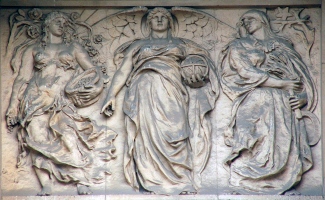
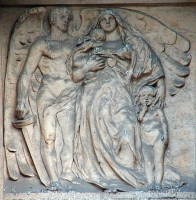
We noted above that Pomeroy was responsible for most of the external sculpture, and the part which was not his consists of the three relief panels behind the central pillars. They are by the sculptor Alfred Turner, rather more familiar for full figure sculpture, who was the sculptor of the Sheffield Queen Victoria memorial, now in Endcliffe Park, and went on to produce Deco figures in the 1920s and 1930s. The central panel shows an angel, if anything more solid than Pomeroy s muscular females, carrying a globe in one hand and gesturing downwards with the other; to left and right are female Valkyrie figures, again of heroic dimensions. On the left as we look at this panel is a figure of Spring, sowing the seeds from a basket, her scanty drapery indicating the warmth of the sun, spring blossom behind her. The figure to the right hand side is Autumn, holding her sickle and a sheaf of corn, with behind her an already bare branch with a star behind, suggestive, as is her thicker clothing, of the coldness and early darkness of the season late in the year. The obvious allegory is 'As ye sow, so shall ye reap', appropriate for a court. The one side panel shows Perseus, as an over-muscled figure carrying the head of Medusa, and in his other hand an impossibly large and heavy sword, point downward sticking into or behind the supine head and body of a dragon. The brawny woman with a shield standing next to him must be Andromeda, but this is certainly not the winsome and lithe visualisation of Andromeda we are familiar with from the paintings of Burne Jones. The allegory would presumably be that Perseus brought Justice to both the wronged Andromeda and to the evil mythological creatures that beset her. The third panel is calmer; a mother with her two children, one a small girl, the other an infant held in the crook of her arm, is sheltered by the protective wing of a male angel, who carries a short, heavy Gladius (Roman sword), indicative of the power of Justice to protect the needy.
Justice figures are common in Victorian and Edwardian sculpture, and a brief discussion and some other examples of allegorical statues of Justice are on this page, as part of a series of pages on allegorical sculpture.
Progress of Communication.
Finally, to note that opposite the Old Bailey is a rather good pair of sculptures above another portico on the two sides of a broken, curved pediment. This is number 16 Old Bailey, and the figures represent The Progress of Communication. The one on the left, a lightly draped female figure with fetching off-the-shoulder top, holds a steam train in her hand. On her headpiece are small wings, recalling Mercury in his role as messenger of the gods, and behind her we can see a ship s wheel. Facing her from the other side is a heroic nude male figure, drapery behind him and across his loins. He rests one hand on an anchor, the other on the prow of a ship, and as a youthful, beardless Greek figure he could be another representation of Mercury, but given his lack of accoutrements and that his female companion has the Mercury helmet, he is more likely to be some generic representation of the Greek spirit of adventure by sea, epitomised by the stories of the Argonauts.
Across the road at the top is the church of St Sepulchre, with interesting monuments inside which are described on a separate page. Other directions noted below.
This page was originally part of a 'sculpture of the month' series, for October 2014. Although the older pages in that series have been absorbed within the site, if you would wish to follow the original monthly series, then jump to the next month (Nov. 2014) or the previous month (Sept 2014). To continue, go to the bottom of each page where a paragraph like this one allows you to continue to follow the monthly links.
West to Holborn Viaduct // and then on to the Prudential Building war memorial // South along Old Bailey and a bit East to St Martin Ludgate // East along Newgate to Christ Church Greyfriars
Iconic sculpture of London // Allegorical statues of Justice
